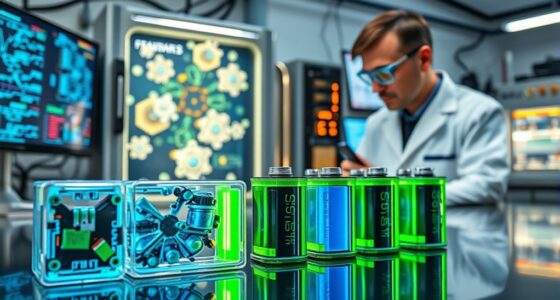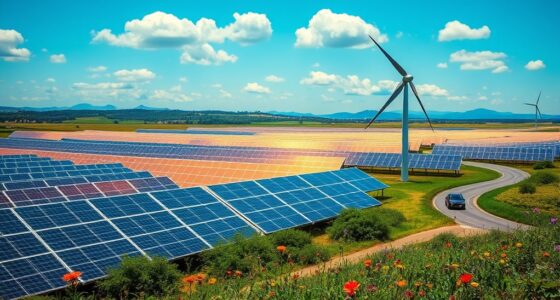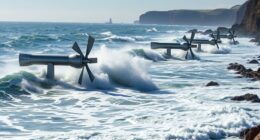Wind energy is a powerful renewable source that cuts greenhouse gas emissions and reduces air pollution. It creates jobs and promotes local economies, but it also comes with high initial costs and potential environmental impacts, like habitat disruption. Turbines can visually alter landscapes and pose risks to wildlife. Balancing these pros and cons is key for sustainable development. There's a lot more to uncover about its economic and social effects.
Key Takeaways
- Wind energy is a clean, renewable resource that significantly reduces greenhouse gas emissions and air pollution.
- High upfront costs and rising material prices pose financial barriers to wind energy development.
- Wind farms create long-term job opportunities and boost local economies, particularly in rural areas.
- Environmental concerns include habitat disruption, wildlife collisions, and visual pollution from turbines.
- Technological advancements are reducing costs and improving the integration of wind energy into power grids.
Overview of Wind Energy
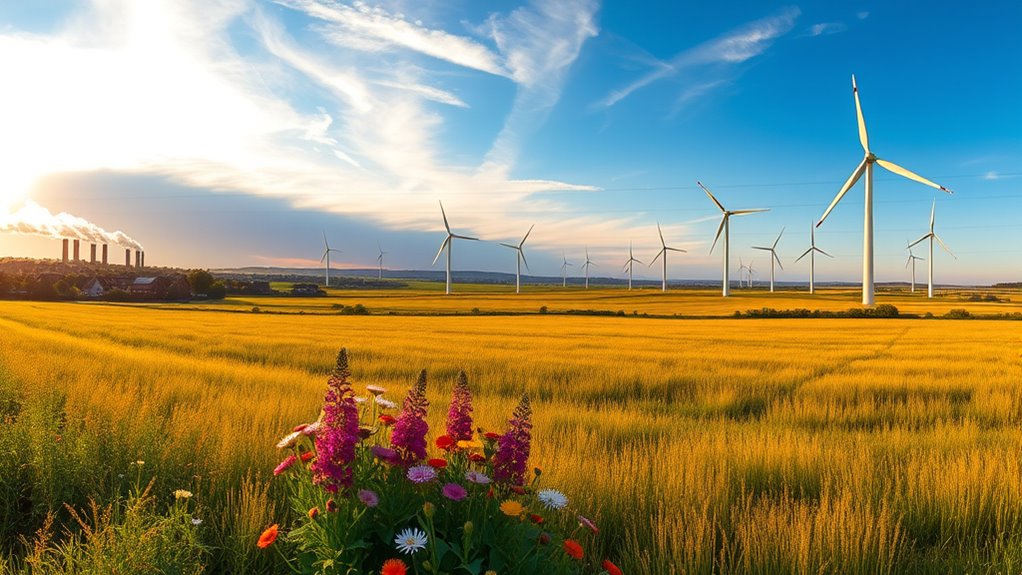
As you explore the world of renewable energy, wind energy stands out as a powerful option that harnesses the natural force of the wind to generate electricity. This renewable source converts kinetic energy into electrical power through wind turbines, often grouped into wind farms connected to the electrical grid.
Since 2000, wind energy has experienced rapid growth due to technological advancements and supportive policies. Modern turbines have significantly improved in capacity and efficiency, now generating over 2,304 TWh of electricity globally as of 2022. Regular maintenance of these turbines is essential to ensure optimal performance and maximize energy output. Proper humidity control in nearby environments can enhance the overall efficiency of energy systems, including wind energy. Additionally, the integration of smart technologies in wind energy systems can further optimize performance and reduce operational costs. This growth illustrates the importance of imagination in rethinking our energy sources for a sustainable future.
Historically, wind energy has been used for tasks like pumping water and grinding grain, but today, it's the largest renewable energy source in the United States, showcasing its vast potential for the future. Wind turbine design influences efficiency, with larger turbines typically generating more electricity due to increased rotor diameter.
Environmental Benefits
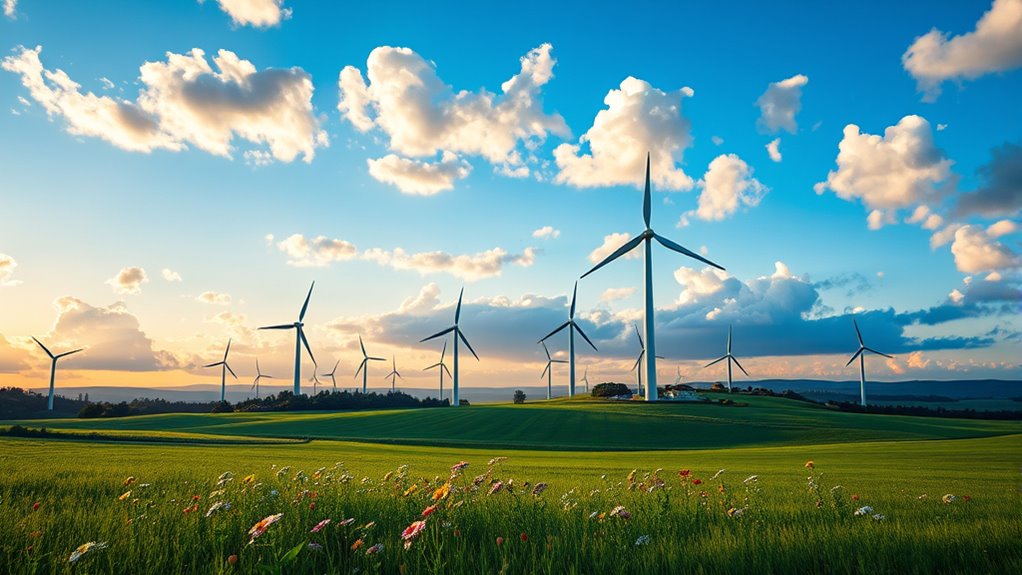
While many energy sources contribute to environmental harm, wind energy stands out for its ability to provide clean, renewable power with minimal negative impacts.
By harnessing wind, you help reduce greenhouse gases, cutting CO2 emissions significantly—115 million metric tons in the US alone in 2013. It also minimizes air pollution, avoiding harmful sulfur dioxide and nitrogen oxides that contribute to smog and health issues. Additionally, solar energy is another clean alternative that complements wind power in reducing overall emissions. The growth mindset in the renewable energy sector encourages continuous innovation that drives efficiency and effectiveness in harnessing wind energy. Moreover, the focus on sustainable practices in various industries, such as tea production, highlights the growing importance of environmentally friendly energy sources. Heat pumps can utilize renewable energy sources like wind to further enhance their efficiency and reduce carbon footprints.
Plus, wind energy saves water, using none in its operations, unlike thermal plants that consume vast amounts. Wind farms can coexist with agriculture and protect natural ecosystems, fostering sustainable development. Additionally, wind energy can indirectly power heat pumps that further enhance energy efficiency and reduce reliance on fossil fuels.
Environmental Concerns

Although wind energy offers significant environmental benefits, it also raises various concerns that need to be addressed.
You should consider that wind farms can disrupt local habitats, potentially harming wildlife and ecosystems. If turbines are placed on peatlands, they risk releasing stored carbon and degrading water quality. Additionally, predictive modeling can help assess the potential ecological impacts before installation. The benefits of choosing the best heat pump can also offer alternative solutions to reduce reliance on fossil fuels, thereby minimizing the overall environmental footprint. Furthermore, the emphasis on community resilience is crucial when implementing renewable energy projects to ensure local support and sustainability.
Moreover, visual pollution from turbines can alter landscapes, impacting scenic views. You might also notice the effects of "shadow flicker" caused by rotating blades, which can be managed through careful siting. Additionally, bird and bat collisions remain a concern, along with potential impacts on marine life from offshore installations. Recent studies indicate that hydrogen can be produced from renewable sources, offering a complementary solution to fossil fuels while minimizing environmental impact. Moreover, wood-burning emissions can exacerbate air quality issues, highlighting the need for cleaner energy alternatives. While the environmental impact is generally minimal compared to traditional energy sources, these issues still warrant careful consideration.
Economic Advantages
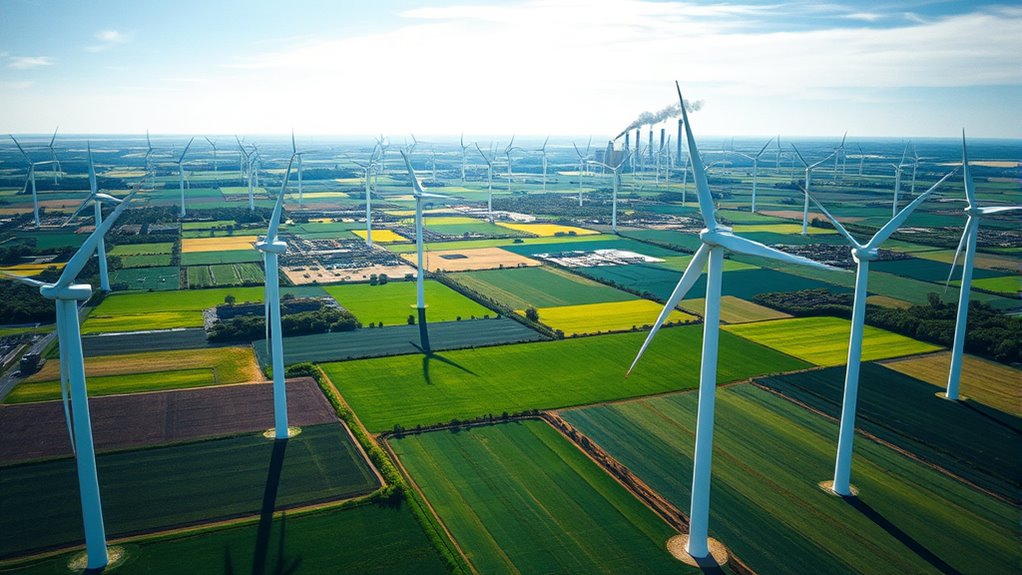
Wind energy not only addresses environmental concerns but also brings significant economic advantages. By investing in wind projects, you create long-term job opportunities in manufacturing, construction, and maintenance. These projects generate crucial revenue through lease payments to landowners and local tax revenues, boosting community income by about $11,000 per megawatt installed. Additionally, wind energy relies on local resources, promoting domestic economic growth and stimulating local economies, especially for farmers and ranchers. As data-driven marketing strategies suggest, leveraging community engagement can further enhance the visibility and support for these projects. With low operating costs and no fuel expenses, wind power remains competitively priced against traditional energy sources. As crowdstrike outage highlights the importance of resilient infrastructure, you can expect substantial economic impacts as wind capacity expands, benefiting not just your community but also surrounding areas. Moreover, the development of wind energy projects can lead to strategic planning initiatives that foster cooperation among stakeholders, enhancing community support and participation. Furthermore, the stability of retirement savings plans can be enhanced through investments in renewable energy projects, providing an additional layer of financial security for individuals and communities alike. Additionally, state-specific benefits for retirees can also encourage investment in local renewable projects, further driving economic growth.
Economic Disadvantages

Despite its many benefits, investing in wind energy comes with significant economic disadvantages that can't be overlooked.
First, the high upfront costs for constructing wind turbines and facilities can be a major barrier. Rising material prices, particularly steel and rare earths, have only increased these expenses. Offshore wind farms are even pricier, deterring smaller projects and community initiatives. Additionally, the importance of infrastructure development is critical for supporting the growth of wind energy projects, but it often requires substantial investment. A well-diversified portfolio can help mitigate some financial risks associated with such large-scale investments. Moreover, investing in renewable energy, like wind, can be influenced by volatile market trends that may impact financial returns. Furthermore, gold IRAs offer tax-deferred growth, which can provide financial stability for investors exploring various energy sectors.
High upfront costs and rising material prices pose significant barriers to wind energy development, especially for offshore projects.
Additionally, wind power competes with cheaper energy sources like gas and solar, limiting its viability in areas with weak winds. Remote locations often lead to higher transport and maintenance costs, while fluctuating energy prices and unstable policies can hinder long-term growth. Furthermore, without stable government support, the economic challenges of wind energy may outweigh its potential benefits, similar to the tax advantages available through Gold IRA accounts that can enhance stability in investment portfolios.
Technical Challenges
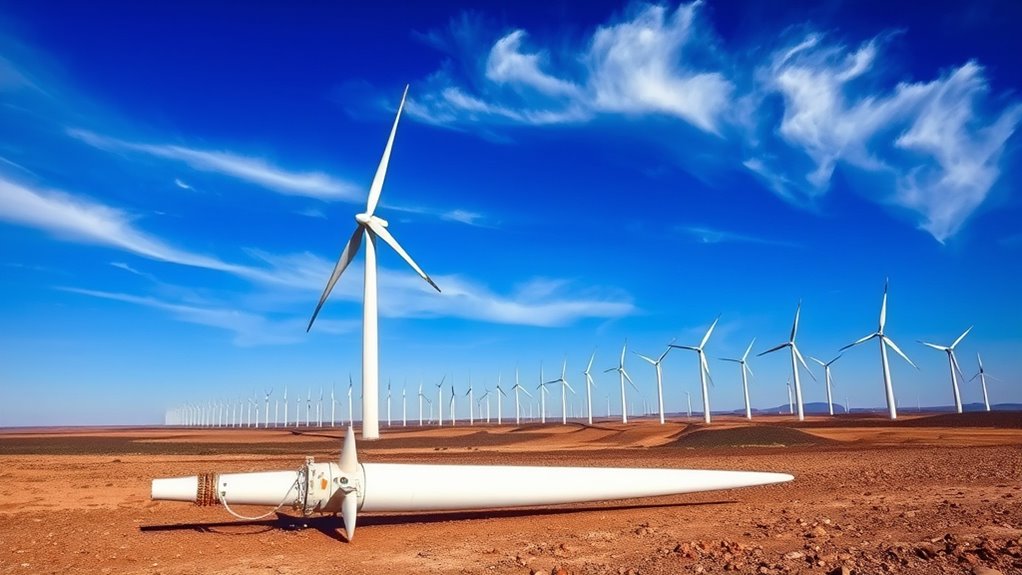
As the demand for wind energy grows, navigating the technical challenges becomes crucial for its success.
You'll need to grasp atmospheric science to optimize turbine performance, which depends on understanding air turbulence and local climates. Turbine design also demands modern modeling tools, as increasing sizes require extensive experimental data. Additionally, implementing risk management strategies will be essential to ensure that wind energy systems are resilient to operational challenges.
Furthermore, integrating wind plants into the electric grid involves complex airflow analysis to maintain stability. Data management through digitalization is essential for processing vast research data. Collaboration across disciplines is key to tackling these challenges.
Additionally, you'll face operational hurdles, such as intermittency and maintenance costs, while exploring innovative solutions like energy storage and advanced turbine designs to enhance efficiency and reliability. Moreover, renewable energy technologies are forecasted to increase efficiency by over 40%, which can significantly benefit wind energy systems.
Social Impacts

Wind energy projects create job opportunities, especially in rural areas, significantly boosting employment rates. As the sector grows, it could support over 100,000 workers, bringing new income sources to local communities and invigorating local economies. Additionally, creating spaces that accommodate the elderly can help enhance quality of life and foster a sense of community among residents. This development stimulates economic growth by fostering new businesses and generating revenue through taxes and lease agreements for local governments. Furthermore, the integration of holistic living practices into community planning can enhance the overall health of residents. Community engagement is crucial; involving locals ensures fairness and helps mitigate social issues. When communities share their knowledge about wind energy, it aids in its effective development, enhancing acceptance and reducing potential controversies. Additionally, diversification strategy in energy sources can lead to more stable and resilient local economies, further reinforcing the benefits of wind energy adoption.
Aesthetic Considerations
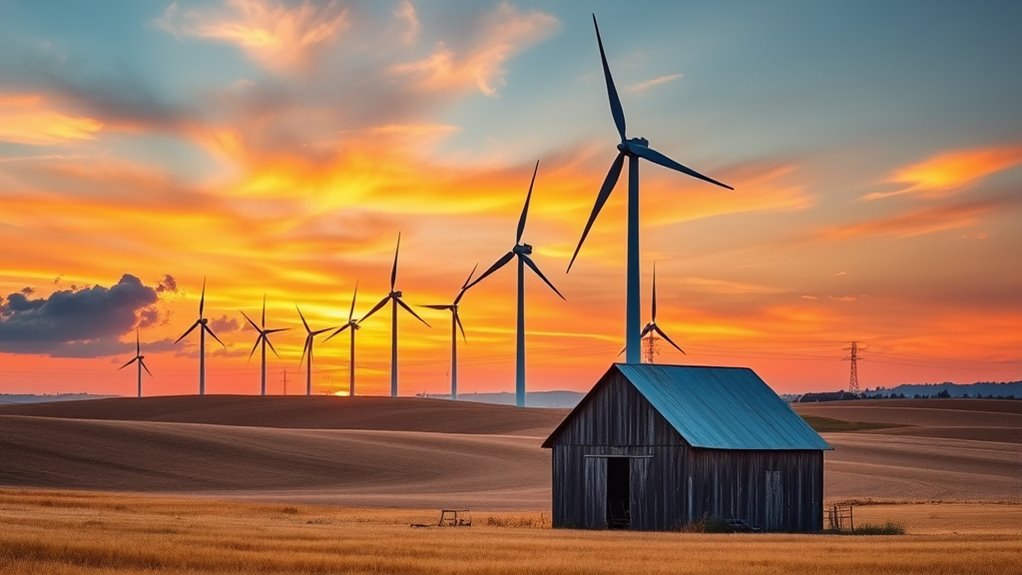
While the benefits of wind energy are often highlighted, aesthetic considerations play a crucial role in the acceptance and integration of wind farms into communities.
You might appreciate that using similar turbines and consistent colors can create visual harmony, reducing clutter in the landscape. Maintaining uniform tower heights and organizing turbines into distinct arrays enhances the overall aesthetic appeal.
Innovative designs, like biomimicry-inspired shapes, further improve visual integration with nature. Additionally, providing educational access about wind energy can foster understanding and acceptance.
Future Potential
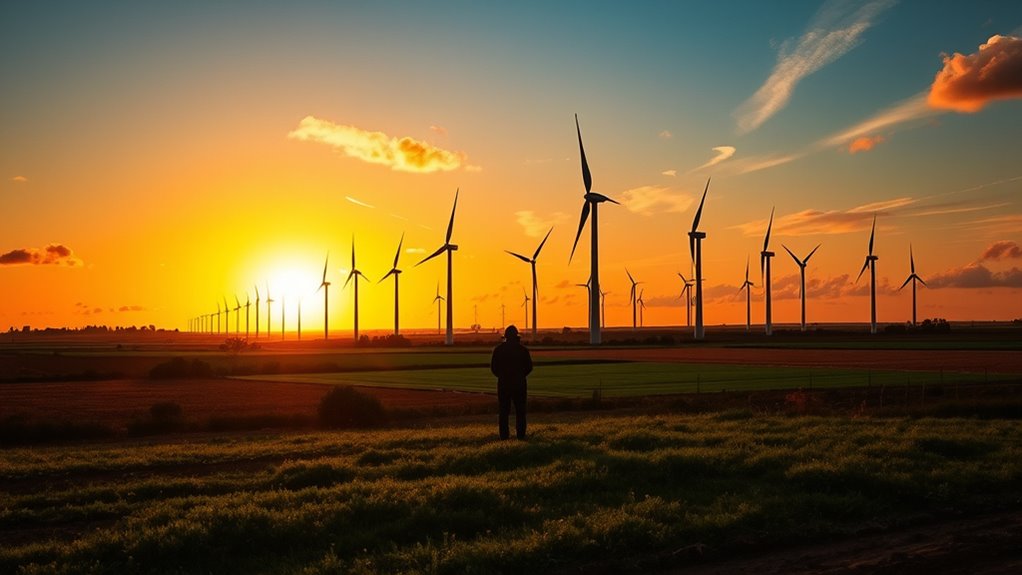
The future potential of wind energy is promising, especially as communities begin to embrace the aesthetic improvements of wind farms. The market's projected growth from $89.6 billion in 2023 to $260.8 billion by 2034 shows strong investment interest.
Offshore projects lead in efficiency, while companies like Vestas and Siemens Gamesa drive innovation. Technological advancements have reduced costs significantly, making wind energy more accessible and appealing.
By 2050, the industry could support over 600,000 jobs and save consumers $280 billion through stable pricing. As wind integrates into power grids, it'll play a crucial role in achieving climate goals, with onshore and offshore capacity needing to expand significantly.
Embracing this shift could mean a more sustainable future for everyone.
Global Significance
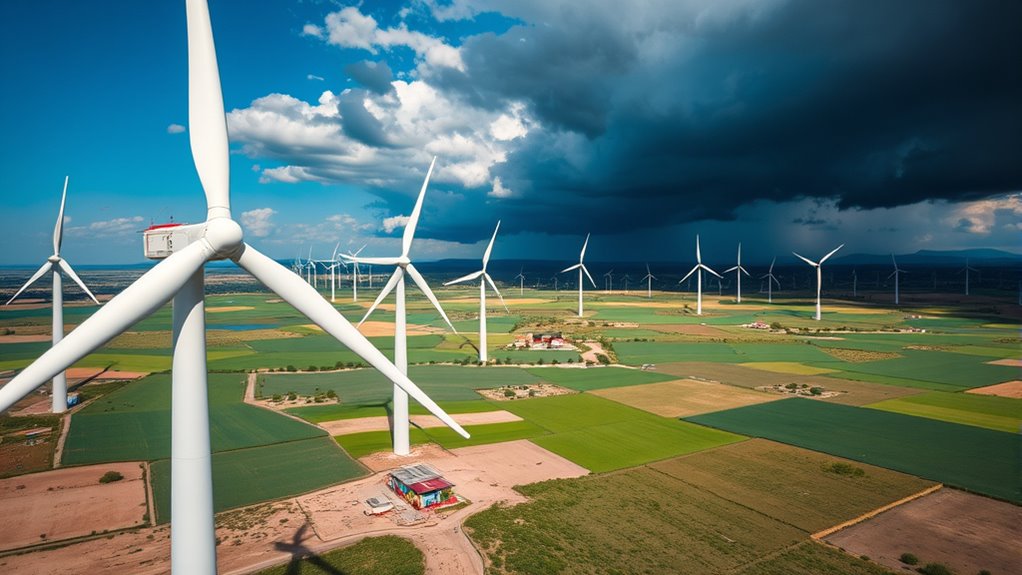
As countries around the world recognize the importance of renewable energy, wind energy's global significance continues to rise.
In 2023, the wind industry added 117 GW of new capacity, a 50% increase from the previous year. This surge bolsters energy independence, helping nations resist supply chain shocks.
The wind industry experienced a remarkable 50% growth in 2023, adding 117 GW of new capacity and enhancing global energy resilience.
China leads in new installations, while the EU and US ramp up investments, especially in offshore wind projects.
Wind energy is reshaping geopolitics, reducing reliance on oil-rich nations and fostering new alliances. It's also central to energy diplomacy, enhancing trade and security.
Frequently Asked Questions
What Materials Are Used to Construct Wind Turbines?
When constructing wind turbines, you'll find a variety of materials used for different components.
Rotor blades often utilize fiberglass, carbon fiber, and composites for durability and efficiency.
Towers are typically made from strong steel or concrete, while generators employ copper and aluminum for conductivity.
Neodymium magnets might enhance efficiency, and many components are recyclable, ensuring a lower environmental impact.
This thoughtful material selection contributes to the overall performance and sustainability of wind energy systems.
How Long Do Wind Turbines Typically Last?
Imagine a giant mechanical bird soaring through the skies for 20 to 25 years.
That's the typical lifespan of modern wind turbines, though proper maintenance can stretch that number.
You'll find components like generators and gearboxes often needing replacement before the turbine reaches its full potential.
Environmental conditions play a role too, but with regular upkeep, you can ensure these towering structures keep spinning efficiently for as long as possible.
Can Wind Energy Power Homes off the Grid?
Yes, wind energy can definitely power homes off the grid.
If you're in a windy area, installing a wind turbine allows you to generate your own electricity.
You'll need to consider your energy demands and possibly combine wind with solar for a more stable supply.
Just remember, you'll need a tall tower for optimal wind capture and a battery backup to store energy for calm days.
With the right setup, you can enjoy sustainable living!
What Is the Average Size of a Wind Farm?
Imagine standing in a vast field, where towering turbines dance gracefully in the wind.
The average wind farm typically consists of about 50 turbines, generating around 506,000 MWh annually.
These impressive structures harness the power of nature, transforming it into clean energy.
You'll find them in areas with optimal wind patterns, like the Midwest and Texas, capturing every gust and breeze to create a sustainable future for all.
How Is Wind Energy Integrated Into the Existing Power Grid?
Integrating wind energy into the existing power grid involves several key technologies and strategies.
You'll need to focus on advanced inverter controls and HVDC transmission for efficient power transfer. By using grid-forming capabilities, wind turbines can stabilize voltage and frequency, mimicking traditional generators.
Additionally, addressing challenges like intermittency and ensuring network resilience through stability analysis and cybersecurity measures are crucial for smooth integration and reliable power supply.
Conclusion
In exploring wind energy, you'll find that its benefits often coincide with its challenges. While harnessing the wind can significantly reduce carbon emissions, it also raises concerns about wildlife and noise. Economically, it creates jobs and cuts energy costs, yet initial investments can be steep. As you weigh these pros and cons, remember that the future of wind energy holds incredible potential to transform our energy landscape and combat climate change, making it a crucial topic for all of us.


